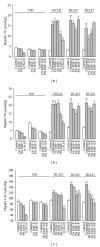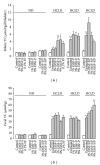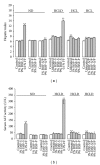Supplementation with the extract of schisandrae fructus pulp, seed, or their combination influences the metabolism of lipids and glucose in mice fed with normal and hypercholesterolemic diet
- PMID: 24876871
- PMCID: PMC4021675
- DOI: 10.1155/2014/472638
Supplementation with the extract of schisandrae fructus pulp, seed, or their combination influences the metabolism of lipids and glucose in mice fed with normal and hypercholesterolemic diet
Abstract
sweet (fruit skin), sour (pulp), bitter/pungent (seed core), and saltiness (all parts), can produce a wide spectrum of biological activities in the body. Here, we investigated the effects of the ethanolic extract of SF pulp, seed, or their combination (namely, EtSF-P, EtSF-S, or EtSF-P/S, resp.; collectively called EtSF) on the metabolism of lipids and glucose in normal diet- (ND-) and hypercholesterolemic diet- (HCLD-) fed mice. Supplementation with EtSF significantly reduced hepatic triglyceride and cholesterol levels by 18-47% in both ND- and HCLD-fed mice. EtSF supplementation reduced serum triglyceride levels (approximately 29%), whereas EtSF-P and EtSF-S/P elevated serum cholesterol (up to 26 and 44%, resp.) in HCLD-fed mice. Treatment with EtSF decreased hepatic glucose levels (by 9-44%) in both ND- and HCLD-fed mice. Supplementation with EtSF-S or EtSF-S/P (at 1 and 3%) increased biliary or fecal TC contents in HCLD-fed mice. However, supplementation with EtSF-S/P at 9% reduced biliary TC levels in HCLD-fed mice. EtSF-P or EtSF-S/P supplementation reduced serum alanine aminotransferase activity in HCLD-fed mice. The findings suggested that supplementation with EtSF lowered lipid and glucose accumulation in the liver and increased fecal cholesterol contents in mice. Dietary supplementation with EtSF-P or EtSF-S/P attenuated liver damage in HCLD-fed mice.
Figures




Similar articles
-
A comparative study between Wuweizi seed and its post-ethanol extraction residue in normal and hypercholesterolemic mice.Lipids Health Dis. 2015 Aug 25;14:93. doi: 10.1186/s12944-015-0097-z. Lipids Health Dis. 2015. PMID: 26303027 Free PMC article.
-
Effects of combined dietary supplementation with fenofibrate and Schisandrae Fructus pulp on lipid and glucose levels and liver function in normal and hypercholesterolemic mice.Drug Des Devel Ther. 2015 Feb 17;9:923-35. doi: 10.2147/DDDT.S73544. eCollection 2015. Drug Des Devel Ther. 2015. PMID: 25733812 Free PMC article.
-
Evaluation of Beneficial and Adverse Effects of a Diet Supplemented with Schisandrae Fructus Seed Ethanol Extract on Lipid and Glucose Metabolism in Normal and Hypercholesterolemic/Hyperglycemic Mice.Evid Based Complement Alternat Med. 2021 Feb 20;2021:8858962. doi: 10.1155/2021/8858962. eCollection 2021. Evid Based Complement Alternat Med. 2021. PMID: 33688367 Free PMC article.
-
Dietary pulp from Fructus Schisandra Chinensis supplementation reduces serum/hepatic lipid and hepatic glucose levels in mice fed a normal or high cholesterol/bile salt diet.Lipids Health Dis. 2014 Mar 12;13:46. doi: 10.1186/1476-511X-13-46. Lipids Health Dis. 2014. PMID: 24621253 Free PMC article.
-
Dietary Fructus Schisandrae extracts and fenofibrate regulate the serum/hepatic lipid-profile in normal and hypercholesterolemic mice, with attention to hepatotoxicity.Lipids Health Dis. 2012 Sep 19;11:120. doi: 10.1186/1476-511X-11-120. Lipids Health Dis. 2012. PMID: 22989092 Free PMC article.
Cited by
-
Comparative analysis of the synergetic effects of Diwuyanggan prescription on high fat diet-induced non-alcoholic fatty liver disease using untargeted metabolomics.Heliyon. 2023 Nov 10;9(11):e22151. doi: 10.1016/j.heliyon.2023.e22151. eCollection 2023 Nov. Heliyon. 2023. PMID: 38045182 Free PMC article.
-
Schisandrae Fructus Reduces Symptoms of 4-Vinylcyclohexene Diepoxide-Induced Ovarian Failure in Mice.Evid Based Complement Alternat Med. 2017;2017:2564787. doi: 10.1155/2017/2564787. Epub 2017 May 11. Evid Based Complement Alternat Med. 2017. PMID: 28584559 Free PMC article.
-
Decoction and Fermentation of Selected Medicinal Herbs Promote Hair Regrowth by Inducing Hair Follicle Growth in Conjunction with Wnts Signaling.Evid Based Complement Alternat Med. 2016;2016:4541580. doi: 10.1155/2016/4541580. Epub 2016 Mar 24. Evid Based Complement Alternat Med. 2016. PMID: 27110266 Free PMC article.
-
A comparative study between Wuweizi seed and its post-ethanol extraction residue in normal and hypercholesterolemic mice.Lipids Health Dis. 2015 Aug 25;14:93. doi: 10.1186/s12944-015-0097-z. Lipids Health Dis. 2015. PMID: 26303027 Free PMC article.
-
Effects of combined dietary supplementation with fenofibrate and Schisandrae Fructus pulp on lipid and glucose levels and liver function in normal and hypercholesterolemic mice.Drug Des Devel Ther. 2015 Feb 17;9:923-35. doi: 10.2147/DDDT.S73544. eCollection 2015. Drug Des Devel Ther. 2015. PMID: 25733812 Free PMC article.
References
-
- van Craeyveld E, Gordts SC, Jacobs F, de Geest B. Correlation of atherosclerosis between different topographic sites is highly dependent on the type of hyperlipidemia. Heart and Vessels. 2012;27(2):231–234. - PubMed
-
- Loria P, Marchesini G, Nascimbeni F, et al. Cardiovascular risk, lipidemic phenotype and steatosis. A comparative analysis of cirrhotic and non-cirrhotic liver disease due to varying etiology. Atherosclerosis. 2014;232(1):99–109. - PubMed
-
- Lin XF, Shi KQ, You J, et al. Increased risk of colorectal malignant neoplasm in patients with nonalcoholic fatty liver disease: a large study. Molecular Biology Reports. 2014 - PubMed
LinkOut - more resources
Full Text Sources
Other Literature Sources

